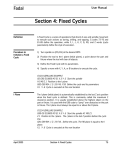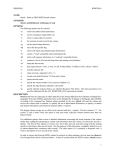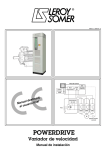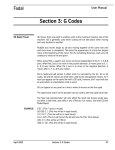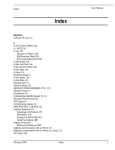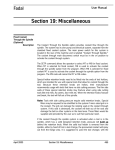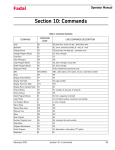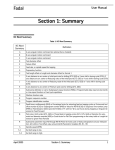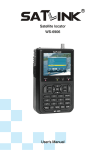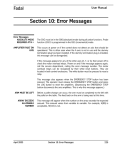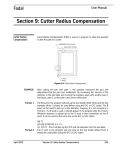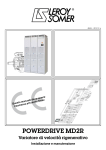Download Section 12: Rotary Axes - Flint Machine Tools, Inc.
Transcript
Fadal User Manual Section 12: Rotary Axes A Axis Direction of Motion Direction of motion is defined as per ANSI/EIA RS-274-D. Since the VMC rotates the work piece, the rotary head must rotate clockwise to achieve a counterclockwise tool motion and visa versa. The positive sign is assumed. The Negative symbol must precede the angular amount. A-90. is correct, -A90. is incorrect. A+ = Counterclockwise work piece rotation (viewing in the X+ direction). A- = Clockwise work piece rotation (viewing in the X+ direction). END POINT G91 (A+90ß) START POINT G91 (A-270ß) Figure 12-1 Direction of Motion G90 Absolute Mode April 2003 In the absolute mode (G90) the A word value defines the final position between 0 and 360. The + or - signs define the direction of rotation. The + sign causes counterclockwise work piece rotation, the - sign causes clockwise rotation to the indicated degree. There are two possible ways to get to a position on the rotary table in absolute: by rotating either from the positive or negative direction. Section 12: Rotary Axes 265 Fadal User Manual EXAMPLE: 1) G90: In absolute terms A+90. and A-90. will position to the same location; however, from different directions. An A+90. will rotate the work piece in the positive (CCW) direction to the absolute 90 degree location. An A-90. will move the table in the negative (CW) direction to the absolute 90 degree location. N1 G0 G90 A90.000 N2 A-0 Block N1 rotates the work piece counterclockwise to the 90th degree position. Block N2 rotates the work piece clockwise to the zero degree position. Changing N2 to a value of A+0 would cause counterclockwise rotation to the zero degree. G91 Incremental Mode In the incremental mode (G91) the A axis value defines the direction and number of degrees to rotate. An A+90. causes the work piece to rotate counterclockwise 90 degrees. If the next move were an A-90. the work piece would rotate clockwise to the original position. EXAMPLE: 1) G91: In incremental terms A+90. and A-270. will position to the same location; however, from different directions. An A+90. will move the table in the positive (CCW) direction 90 degrees from its current position. An A-270. will move the table in the negative (CW) direction 270 degrees from its current position. N1 G0 G91 A+90. N2 A-90. Block N1 rotates the work piece counterclockwise 90 degrees. Block N2 will rotate the work piece clockwise 90 degrees. A Axis Cold Start The A axis markers must be aligned during the cold start procedure. The mark on the face plate and the mark on the body of the A axis must be in line before using the CS command. A Axis Home Position The A axis can be set to zero at any angle by using the SETA command. The SETA command will store the current A axis position into memory as the A axis home position. When the CS command is used and the move to home question appears the A axis position appears, at the bottom of the screen, along with the XYZ and B axis positions. 266 Section 12: Rotary Axes April 2003 Fadal User Manual EXAMPLE: 1) Jog the fixture or part until it is level. 2) From the command mode, type SETA, then press ENTER. 3) The A axis should now be set to zero. Move to Home The G28 code in format one and the HO command return the rotary head to the set point along with the X and Y axes. In format two, a G90 G28 X0 Y0 A0 needs to be coded so that the A axis will move home with the X and Y axes. 1) If the current Z axis position is above (+) the HOME position, the X, Y and A axis moves to zero first, then the Z axis moves in the negative direction. 2) If the current Z axis position is below (-) the HOME position, the Z axis moves in a positive direction (to zero) first, then the X, Y, and A axis move to zero. After the HO moves are computed, the CNC enters the waiting state. The operator can command the execution of the moves by pressing the START key or abort the moves by pressing the MANUAL key. ! WARNING: This move will always be in the direction that is the shortest distance back to A0. 0˚ 180˚ 180º OR GREATER FACEPLATE ROTATES 'CCW' TO GET HOME LESS THAN 180º FACEPLATE ROTATES 'CW' TO GET HOME Figure 12-2 Move to Home Jog Mode April 2003 Jogging the A axis in the positive direction causes the work piece to rotate counterclockwise when viewing in the X+ direction. Relative tool motion would be clockwise. Jogging the A axis in the negative direction causes the work Section 12: Rotary Axes 267 Fadal User Manual piece to rotate clockwise when viewing in the X+ direction. Relative tool motion would be counterclockwise. A Axis Brake Use the M60 code to activate the A axis brake. The brake will remain activated until the M61 is coded or another A axis move is made, either from the program or jog. EXAMPLE: N1 G90 G0 M61 Y-2.3 X1.3 Brake off N2 Z1.6754 A90. M60 Z and A axis move then brake on An M-60 is used with an A move when using fixed cycles so that the cycle will not execute until the brake is applied. EXAMPLE: N10 G82 G99 R0+.1 Z-.25 F45. P130 N11 A30. M-60 N12 A60. M-60 On line N11 and N12 the A axis moves into position, the brake is applied, then the cycle is executed. Decimal Degrees A axis values are given in decimal degrees. EXAMPLE: Numerical Format d° = Degrees m’ = Minutes s" = Seconds DD = Decimal degrees 40°30’13" = 40.50361 d° m’ s" = DD DD= d° + (( m’ + ( s" / 60)) / 60 )) No more than seven numbers are allowed. A##.##### A###.#### A####.### Note: The decimal point is required for all angles except for A0. 268 Section 12: Rotary Axes April 2003 Fadal User Manual Maximum & Minimum Angular Limits START POINT G90 (A+90ß) END POINT G90 (A-90ß) Y+ X+ Figure 12-3 Max. & Min. Smallest: A.002 Largest: A1080. Programming a G91 G1 X2. A1080. will cause an interpolated move where the X axis moves 2. and the A axis moves 1080. degrees. When a fixed cycle is used, A axis motion will cause execution of the cycle. April 2003 Section 12: Rotary Axes 269 Fadal User Manual EXAMPLE: N1 M6 T1 N2 (TOOL #1, DRILL N3 G0 G90 S10000 M3 E1 X0 Y0 A30. N4 H1 D1 M7 Z.1 N5 G81 G99 R0.1 Z-.5 F40. X.5 N6 X2.5 N7 A90. N8 X.5 N9 A150. N10 X2.5 N11 A210. N12 X.5 N13 A270. N14 X2.5 N15 A330. N16 X.5 N17 G80 N18 M5 M9 N19 G0 G90 H0 Z0 A0ß Y0 Z0 60ß X0 0ß 30ß 60ß TYP .50 2.0 Figure 12-4 The A axis can be interpolated along with any other axis. For example, an X and A axis move can be programmed on one line using the G1 code. The X and A axis moves will both end at the same time. Note: A G2 or G3 will not accept an A axis move in the same line. (See Flat Cam Programming). 270 Section 12: Rotary Axes April 2003 Fadal User Manual EXAMPLE: N18 M6 T3 N19 (TOOL #3, 3/8 (.375) 2FL EM N20 G0 G90 S8000 M3 E1 X3.5 Y0 A0 N21 H3 D3 M7 Z.1 N22 G1 Z-.27 F10. N23 G91 F50. N24 X1. N25 X-1.A-30. N26 X-1.A30. N27 A90. N28 X2. N29 A-90. N30 X1. N31 Z.1 G0 N32 M5 M9 1.00 1.00 30ß 90ß 2.00 Figure 12-5 Degree Feedrate Calculation The actual move distance must be calculated before the feed rate can be determined. This distance may be estimated; however, for best results use the equation below. The following example is programmed for a part with a diameter of 4.0. The desired cut is 90 degrees interpolated with an X axis move of 3.0 (see line N6 of the example program below). The feed rate used for calculation was 25 ipm. Actual move distance = Sqrt (((Dia. of surface to be cut * 3.14159) / (360 / Degrees of rotation))2 + X2) EXAMPLE: Actual move distance = Sqrt (((4 * 3.14159) / (360 / 90))2 + 3.02) = Sqrt ((12.56636) / 4)2 + 9) = Sqrt ((3.14159)2 + 9) = Sqrt (9.8696 + 9) = Sqrt (18.8696) = 4.3439 (G94) Feed Rate = Degrees of Rotation / (Actual Move Distance / Desired Feed Rate) April 2003 Section 12: Rotary Axes 271 Fadal User Manual EXAMPLE: Feed rate EXAMPLE: G94 = 90 / (4.3439 / 25) = 90 / .173756 = 517.97 N1 M6 T1 N2 (TOOL #1, 1/2 END MILL N3 G0 G90 S5000 M3 E1 X0 Y0 A0 N4 H1 M8 Z.1 N5 G1 Z0 F25. N6 X3. A90. F517.97 N7 X1. 25 Inches per Minute move N8 X3. A90. 517.97 Degrees per Minute N9 G90 G0 H0 Z0 Note: The machine control default is G94, therefore it is not required to code the G94 into the program if degrees per minute is used. Note: An F word, on a line with an A axis move only, represents degrees per minute. Feed Rate Specification in Degrees per Minute G93 - 1/T (Inverse Time) 272 Table 1: Feed Rate Specification Axis Ratio Maximum Rapid Traverse Maximum Programmable Feed Rate 360:1 2000 1250 180:1 4000 2500 120:1 6000 3750 90:1 8000 5000 72:1 10000 6250 The G94 code is used more commonly than the G93. G93 was used by controls that did not interpolate XA or YA moves. The advantage of using G94 (the default code) is to allow the programmer to switch between ipm and dpm with no code cancellation. Except for code cancellation, G94 and G93 effectively cut the A axis interpolated move in the same way. Section 12: Rotary Axes April 2003 Fadal User Manual The following example is programmed for a part with a diameter of 4.0. The desired cut is 90 degrees interpolated with an X axis move of 3.0 (see line N6 of the example program below). The feed rate used for calculation was 25 ipm. Actual move distance = Sqrt (((Dia. of surface to be cut * 3.14159) / (360 / Degrees of rotation))2 + X2) EXAMPLE: Actual move distance = Sqrt (((4 * 3.14159) / (360 / 90))2 + 3.02) = Sqrt ((12.56636) / 4)2 + 9) = Sqrt ((3.14159)2 + 9) = Sqrt (9.8696 + 9) = Sqrt (18.8696) = 4.3439 (G93) Feed Rate = 1 / (Actual Move Distance / Desired Feed Rate) EXAMPLE: Feed rate EXAMPLE: G93 = 1 / (4.3439 / 25) = 1 / .17376 = 5.755 N1 M6 T1 N2 (TOOL #1, 1/2 END MILL N3 G0 G90 S5000 M3 E1 X0 Y0 A0 N4 H1 M8 Z.1 N5 G1 Z0 F25. N6 G93 X3. A90. F5.76 N7 G94 N8 X1. N9 G93 X2. A30. F11.07 N10 G94 N11 G90 G0 H0 Z0 All moves in this example from N6 to N9 are equivalent to a feed rate of 25 ipm linear interpolation. April 2003 Section 12: Rotary Axes 273 Fadal G15 - YZA Circular Interpolation User Manual This code is used to interpolate Y, Z arcs while making simultaneous A axis movement. This code is used when it is necessary to cut an arc with the bottom of the end mill. G15 may also be used with a ball nose end mill. START POINT BEFORE ROTATION END POINT AFTER ROTATION G91 Y Figure 12-6 Note: When the center of the arc to be cut is not the same as the center of rotation on the A axis, G15 must be used to cut the radii (see picture below). The following diagram shows the information required to program G15. J K Figure 12-7 The G15 arc requires four descriptors: end point, center description, A axis rotation, and the G2 or G3 code. These four elements are determined as follows: 1) End point description: a. Incrementally Y and Z axis moves are described as the direction and distance from the start point, prior to A axis rotation, to the end point, after the A axis rotation. b. In absolute terms the Y and Z axis end positions are given as the absolute locations after rotation. 2) Center description: a. The J is the incremental Y direction and distance from the Y axis start point to the center of A axis rotation. 274 Section 12: Rotary Axes April 2003 Fadal User Manual b. The K is the incremental Z direction and distance from the center of the arc to be cut to the center of A axis rotation. A- FOR CCW TOOL MOTION 1.000 START POINT .500 END POINT Y (G91) J START POINT G3 Z (G91) K .800 .400 A AXIS ROTATION AMOUNT R .10 (4)PL A AXIS CENTER PART BEFORE ROTATION PART AFTER ROTATION ƒÓ1.50 Figure 12-8 Z+ Y+ Y- 3) A axis description: a. Incrementally the A axis rotation is given as the angle between the end point at the beginning of the move and the end point at the end of the move (See picture below). b. In absolute terms this would be given as the absolute angle of the part at the end of rotation. Figure 12-9 4) G2 or G3 description: a. The arc direction coding is based on viewing the part looking in the X+ direction. A clockwise arc uses a G2 code and a counterclockwise arc uses a G3. April 2003 Section 12: Rotary Axes 275 Fadal 276 User Manual EXAMPLE: N1 (G15 RECTANGLE N2 (X0 IS END OF PART, Y0 IS CENTER, Z0 IS TOP OF 1.5 DIA PART N3 G90 G0 X.3 Y-1.5 E1 A0 S5000 M3 N4 H1 Z-.35 M8 N5 G91 G8 G1 Y1.9F10. N6 G15 N7 Y-.7 Z.1 J-.4 K-.3 A-90. G3 N8 G90 Y.6 N9 G91 Y-.7 Z-.1 J-.3 K-.4 A-90. G3 N10 G90 Y.8 N11 G91 Y-.7 Z.1 J-.4 K-.3 A-90. G3 N12 G90 Y.6 N13 G91 Y-.7 Z-.1 J-.3 K-.4 A-90. G3 N14 M5 M9 N15 G90 G0 H0 Z0 N16 E0 X0 Y0 A0 N17 M2 EXAMPLE: N1 (G15 CRANKSHAFT N2 (X0 IS END OF PART, Y0 IS THE CENTER, Z0 IS THE TOP OF 1.5 DIA N3 (TOOL IS A .5 DIA CENTER CUTTING 2FL EM N4 G90 G0 S5000 M3 E1 X.45 Y0 A0 N5 H1 Z.1 M8 N6 Z-.05 G1 F10. N7 G15 N8 G91 N9 Y0 Z0 J0 K-.45 A-360. G3 N10 G90 N11 Z.1 G0 N12 X1.15 A180. N13 Z-.05 G1 N14 G91 N15 Y0 Z0 J0 K-.45 A-360. G3 N16 G90 G0 Z.1 N17 M5 M9 N18 G90 G0 H0 Z0 N19 E0 X0 Y0 A0 N20 M2 Section 12: Rotary Axes April 2003 Fadal Flat Cam (Cam Wrapping) Programming User Manual Flat cam programming is used when an XY program needs to be “wrapped” around the circumference of the part. This function is designed to convert Y axis motion into A axis motion. XA conversion is used when the A axis is the rotary table, YB conversion is used when the B axis is the rotary table. Figure 12-10 Flat Cam The conversion from Y to A axis moves is defined in the program by using a G17 and Q word in the same line. The Q word represents a number used by the control for converting the Y or X axis moves to A or B axis moves. Wrapping X on B Axis Y axis wrapping is assumed. Use G17 Q word P1 on the same line in the program for YB wrapping. All information for Y to A wrapping applies to X to B wrapping. Cam Diameter The cam diameter to be used is usually given on the blueprint. If it is not given, use the outside diameter of the part for the cam diameter. Y axis moves, when wrapped, are measured along the circumference of the cam diameter. Note: The angular move for one inch of Y axis motion for CAM DIA. 1, is less than the angular motion for one inch of CAM DIA. 2 (see the picture above). April 2003 Section 12: Rotary Axes 277 Fadal User Manual A Axis Ratio Each rotary table has an axis ratio. Not all manufactures keep the same ratio. This number is affected by the gear ratio of the axis. The manual for each rotary head contains the A axis ratio number to use for calculating the Q word. 1" ALONG THE CIRCUMFERENCE OF DIAMETER 1 CAM DIA 1 A AXIS MOTION B AXIS MOTION CAM DIA 2 1" ALONG THE CIRCUMFERENCE OF DIAMETER 2 Figure 12-11 A Axis Ratio Q Word A axis ratio = 90 to 1, cam diameter = 4., pi = 3 .14159 (Inches) Q = A axis ratio / (5 * pi * (cam diameter in inches)) 5= counts constant Q = 90 / 5 * 4 * 3.14159 Q = 90 / 20 * 3.14159 Q = 90 / 62.8318 Q = 1.4324 (Metric) Q = A axis ratio / ((5/25.4) * pi * (cam diameter in millimeters)) Unwrapping Prior to canceling the G17 Q word code, the Y axis must be “unwrapped” so that the A axis can return to its original position. 1) The position of the Y axis, when the G17 Q word is coded, establishes the original position of the A axis. 278 Section 12: Rotary Axes April 2003 Fadal User Manual 2) Returning the Y axis to its original position should return the A axis to its original position. The A axis position read out on the screen must be the same position that it started from to be fully unwrapped. The Q word can be altered to attain this. 3) An absolute or incremental Y axis move can be used to return the Y axis to its place of origin. G90 If the program moves the Y axis Y+5., then the unwrapping move would be Y0. G91 If the program moves the Y axis Y+5., then the unwrapping move would be Y-5. April 2003 Section 12: Rotary Axes 279 Fadal User Manual Canceling Cam Wrapping Directly after the unwrapping move, cancel the flat cam programming function by coding a G17 on a line by itself. EXAMPLE: N1 O1 (FLAT CAM PROGRAM EXAMPLE N2 M6 T1 N3 (TOOL #1, 1/2 2 FL E.M. USE .5 IN THE TOOL TABLE N4 G0 G90 S2000 M3 X0 Y0 A0 N4.5 G51.1 Y0 It is important to mirror the Y axis N5 H1 D1 M8 Z.1 N6 G17 Q1.4324 This line starts Flat cam conversion (see Q word) N7 X1.125 Y-2.125 N8 G1 Z-.27 F25. N9 G1 G42 X2.125 To maintain a climb cut on a mirrored path, use G42 Figure12-12 N10 Y-.25 N11 X1.875 Y0 I-.25 G3 N12 X.25 N13 X0 Y-.25 J-.25 G3 N14 Y-4.5 N15 X.322 Y-5.2437 I1.02 G3 N16 X.625 Y-5.9437 I-.657 J-.7 G2 N17 Y-6.5 N18 X2.125 I.75 G3 N19 Y-3.375 N20 X1.125 G40 N21 Z.1 G0 N22 Y0 Return to original Y position (unwrapping move) N22.5 G50.1 Turn off mirror N23 G17 This line cancels the Flat cam conversion N24 M5 M9 Figure 12-13 N25 G90 G0 H0 Z0 2.125 4.50 6.50 R 1.02 R .96 R .75 (FULL RADIUS) 280 Section 12: Rotary Axes April 2003 Fadal User Manual Note: Rapid movements (G0 or G5) are reduced in speed during the flat cam conversion. 400 / Q word amount = new rapid rate 400 / 1.4324 = 279.25 IPM Mid Program Start Mid program starts may not be executed after the G17 Q word which is used to start the cam wrapping feature. The mid program start feature can be used on any line before the G17 Q word and after the G17 that is used to cancel cam wrapping. Writing a Cam Wrapping Program When writing a program to be wrapped, mirror the Y axis with a G51.1 Y0 at the beginning of the program, just before the G17 Q#, and exchange all G41 codes to G42. (See the program example above.) Cam Wall Angles A axis machining can produce two different cam wall angles. The cam walls may intersect or they may be parallel. These wall angles are determined by the programming methods used. The wall configuration required is established by the part blueprint. Note: Flat cam conversions will produce walls that intersect (see picture below). Figure 12-14 April 2003 Section 12: Rotary Axes 281 Fadal User Manual Review the print to determine whether the walls on the print intersect or are parallel. Place a straight edge on a wall on the print to help determine if the walls intersect. Figure 12-15 Note: If the walls are parallel, DO NOT use flat cam (cam wrapping) conversions (see picture above). Figure 12-16 Parallel walls are normally associated with slots or grooves. These parallel walls can be maintained by using a cutter that is the same diameter as the width of the slot. When the slot is wider than the cutter, Y axis movements must be made to maintain parallel walls. Parts that have parallel walls, such as slots or grooves, are usually parallel because a follower pin must fit into the slot or groove. 1) Start cutting the slot by programming the center of the groove, and cut with an undersized cutter. This cutter must be undersized enough to account for cutter deflection. 2) Use the same programmed path to make a second cut with a full- sized cutter. 282 Section 12: Rotary Axes April 2003 Fadal User Manual Parts with parallel walls can be cut by using a cam system that provides this feature. These systems allow for the Y axis to be offset to account for cutter radius compensation, if required. Tilt Rotary Table Direction of Motion Direction of motion is defined as per ANSI/EIA RS-274-D. Some tilt rotary tables are set up with the B axis as the tilt portion and others with the A axis as the tilt portion. All rotary table information for a tilt rotary table can be read in the A axis portion of this section. Since the VMC tilts the work piece, the tilt must be clockwise to achieve counterclockwise tool motion and visa versa. Note: The positive sign is assumed. The negative symbol must precede the angular amount. B-90. is correct, -B90. is incorrect. B Tilt Table B+ = Counterclockwise work piece rotation (viewing in the Y+ direction). B- = Clockwise work piece rotation (viewing in Y+ direction). A Tilt Table A+ = Counterclockwise work piece rotation (viewing in the X+ direction). A- = Clockwise work piece rotation (viewing in X+ direction). Tilt Cold Start The tilt table axis markers must be aligned before using the CS command. Tilt Home Position Jog the tilt table to the desired degree for home position. Then use the SETB or SETA command, whichever applies, to establish the tilt home position. This position is stored in memory and when the next CS command is used, the tilt table will return to this location. April 2003 Section 12: Rotary Axes 283 Fadal User Manual Axis Limits The tilt limits are as follows: 1) B tilt table: • 105 degrees - from the cold start position • 15 degrees + from the cold start position 2) A tilt table: • • 105 degrees + from the cold start position 15 degrees - from the cold start position B-105˚ A+105˚ CS A-15˚ Z+ CS B+15˚ Z+ X+ Y+ Figure 12-17 Tilt Table Brake EXAMPLE: 284 To activate the brake for the tilt table use the M62 code. When the next tilt axis move is made, the brake will automatically release. M63 can be used to release the tilt table brake. N1 G90 G0 M63 Y-2.3 X1.3 Brake off N2 B+315. M62 B tilt move then brake on Section 12: Rotary Axes April 2003 Fadal User Manual G90 Absolute Mode In the absolute mode, the tilt angular value defines the final position between 15 and 265 degrees. The + or - signs define the direction the table will move to get to the degree of tilt. Care must be used in selecting the proper sign for tilt to prevent over travel. 265˚ 270˚ 270˚ 315˚ 265˚ 315˚ A+ B- 0˚ 0˚ 15˚ 15˚ Z+ A- Z+ B+ X+ Y+ Figure 12-18 G90 Absolute Mode EXAMPLE: In absolute terms B+10. will tilt the B axis counterclockwise to the 10th degree. In absolute terms B-270. will tilt the B axis clockwise to the 270th degree. In absolute terms A-10. will tilt the A axis clockwise to the 10th degree. In absolute terms A+270. will tilt the A axis counterclockwise to the 270th degree. G91 Incremental Mode In the incremental mode (G91) the tilt value defines the direction and number of degrees for the tilt table to move. A B+10. causes the table to tilt positively (CCW) 10 degrees from its current position. A B-10. causes the table to tilt negatively (CW) 10 degrees from its current position. B+90˚ A-90˚ A+90˚ Z+ B-90˚ Z+ X+ Y+ Figure 12-19 G91 Incremental Mode EXAMPLE: April 2003 In incremental terms B+90. tilts the table 90 degrees counterclockwise from its current position. Section 12: Rotary Axes 285 Fadal User Manual In incremental terms B-90. tilts the table 90 degrees clockwise from its current position. In incremental terms A+90. tilts the table 90 degrees counterclockwise from its current position. In incremental terms A-90. tilts the table 90 degrees clockwise from its current position. Feed Rate Feed rate is addressed by use of the F word and a G01 code. Tilt motion is programmed in degrees per minute. For example; G91 G01 B+45. F50.0 rotates the B axis 45 degrees at 50 degrees per minute. Use the following chart to find the maximum programmable feed rate for selected device. See the degree feed rate calculation information in this section for details. A & B Fixtures Offsets 286 A & B Fixtures offsets are relative from the E0 or SETA, SETB position. This fixture offset value (in the fixture table) is an absolute value relative to zero. Within the program the direction of motion is specified by + (positive) or (negative). For Rotary table see figure 1, for Tilt see figure 2. Section 12: Rotary Axes April 2003






















